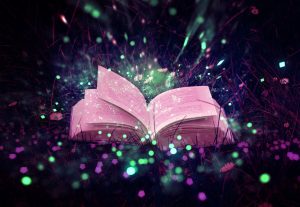Story elements
Think of a fairytale. Pick one of your favourites – a story you know very well. Hold the story in your mind: how does it begin? What are its twists and turns? What happens to the characters? How do we know we’ve reached the ending – what sense of resolution does it give us?
Now imagine how this fairytale would transform if it were told in different ways:
- As a stand-up comedy routine
- As a one-minute video on TikTok
- As a long-running drama on Netflix
- As a news story
- In a different genre (for example, horror or science fiction)
- As a video game
- As a three-picture story without words
- As a single image with a caption
Pick one of these “new forms” – one that stands out to you – and spend a moment mapping out what your transformed fairytale would look like.

Image by Yuri_B on Pixabay
Now take a look at your transformed fairytale, and consider these two questions:
- What makes this new, adapted story the same story as the original tale?
- What did you change, and why?
It’s likely that you kept certain “elements” of the original story: perhaps a character, a plot development, a theme or message, a setting or world. James Paul Gee uses the term story elements to describe the way stories work in video games. He identifies certain “elements” – actors, objects, actions, states, and events – of which stories are composed, and which in the context of video games become items that the player manipulates as they interact with the storyworld (Gee 2005: 59). I find Gee’s idea of story elements to be relevant outside the space of video games as well. In adapting your fairytale, you probably identified “elements” that you felt were important to the story – from objects (the poisoned apple of Snow White) to settings (the subarctic snowscapes of The Snow Queen) to plot developments (Beauty falling in love with the Beast).
However, when you re-housed the story in a new genre or a new format, you also changed particular elements to suit the story’s new home. Maybe you altered the gender, age, personality, or actions of the main character, or transformed a previously marginalised character into the hero. Maybe you modernised the world or darkened the themes. If you were adapting your fairytale as a Netflix drama, you probably thought about extending and complicating the narrative so that it suited the new format – but if you were reimagining your fairytale as an image or a three-picture-story, you found ways to simplify or condense the narrative into recognisable visual features. If you were adapting your fairytale into a news story, you would have changed the way you delivered information to your reader – you probably told the end of the story first, to suit the conventions of newswriting which demand that the most important information (the who, what, where, and when) appears at the beginning of the story. Perhaps, keeping in mind the focus of the previous chapter, you thought about your audience – were you shifting the fairytale from a child to an adult audience, and if so, what narrative transformations did this require or unlock?
This exercise tells us three very important things about storytelling.
- Stories contain particular elements that contribute to the pleasures they offer.
- Stories transform and can be retold – and when they are retold, they offer a combination of new and familiar narrative pleasures.
- Storytelling is a communication process that extends far beyond the classic fairytale or bedtime picture-book. Storytelling is relevant to communicators of all sorts: photographers, journalists, screenwriters, performers, artists, influencers, and more.
This chapter is about storytelling, and its inclusion in this book acknowledges that storytelling is a fundamental and vital part of human communication: it is at once a skill, a strategy, and also something deeper – an implicit relationship between communicator and audience. And as a fundamental and vital part of communication, storytelling is both familiar and challenging. On the one hand, telling stories is something we do all the time, at multiple points in our daily life (have you told a story today? You probably have!). On the other hand, it’s a craft and a skill that can take years to learn and can be difficult to get right. But when we do get it right, good storytelling can change the world.
In this chapter…
Story features and narrative pleasures
Storytelling as a communication tool
“Read the room”: images, signs, and stories
Case study – the semiotics of anthropomorphized animals in the Philippines
To continue reading Chapter 4, click “Next” in the bottom right corner or follow this link.

